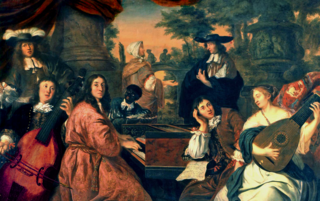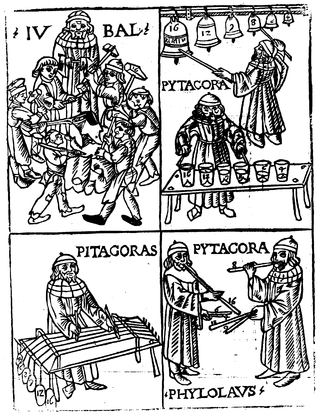References and further reading
- Fredrich Suppig, Labyrinthus musicus, Calculus musicus, facsimile of the manuscripts. Tuning and Temperament Library volume 3, edited by Rudolf Rasch. Diapason Press, 1990.
- Suppig Unveiled
Friedrich Suppig was an 18th-century music theorist and composer. Practically nothing is known about him or his life, or even if he was in fact a professional composer. He is known for two manuscripts; in one of which he discussed theoretical tuning systems:
Both manuscripts are dated Dresden, 24 June 1722.
Johann Mattheson mentioned the Labyrinthus musicus in his Critica musica (1722), describing Suppig as an organist in the Dresden suburbs. In 1863, the document was in the possession of Louis Kindscher of Köthen who mentioned the work in the periodical Euterpe (22, 1863). Although the manuscripts were dedicated to the government of Dresden, the surviving documents surfaced in Köthen in the 19th century. It follows that either they did not become the property of the city of Dresden, or that they were returned to Suppig for some reason, or else they are copies.
The House of Ascania was a dynasty of German rulers. It is also known as the House of Anhalt, which refers to its longest-held possession, Anhalt.

Carl Friedrich Abel was a German composer of the pre-Classical era. He was a renowned player of the viola da gamba, and produced significant compositions for that instrument. He was director of music at the Dresden court from 1743, and moved to London in 1759, becoming chamber-musician to Queen Charlotte in 1764. He founded a subscription concert series there with Johann Christian Bach.

Zwickau (German pronunciation: [ˈtsvɪkaʊ]; is, with around 87,500 inhabitants, the fourth-largest city of Saxony after Leipzig, Dresden and Chemnitz and it is the seat of the Zwickau District. The West Saxon city is situated in the valley of the Zwickau Mulde, and lies in a string of cities sitting in the densely populated foreland of the Elster and Ore Mountains stretching from Plauen in the southwest via Zwickau, Chemnitz and Freiberg to Dresden in the northeast. From 1834 until 1952, Zwickau was the seat of the government of the south-western region of Saxony.

Timpani or kettledrums are musical instruments in the percussion family. A type of drum categorised as a hemispherical drum, they consist of a membrane called a head stretched over a large bowl traditionally made of copper. Thus timpani are an example of kettle drums, also known as vessel drums and semispherical drums, whose body is similar to a section of a sphere whose cut conforms the head. Most modern timpani are pedal timpani and can be tuned quickly and accurately to specific pitches by skilled players through the use of a movable foot-pedal. They are played by striking the head with a specialized drum stick called a timpani stick or timpani mallet. Timpani evolved from military drums to become a staple of the classical orchestra by the last third of the 18th century. Today, they are used in many types of ensembles, including concert bands, marching bands, orchestras, and even in some rock bands.

Köthen is a town in Germany. It is the capital of the district of Anhalt-Bitterfeld in Saxony-Anhalt, about 30 km (19 mi) north of Halle.

Johann Adam Reincken was a Dutch/German organist and composer. He was one of the most important composers of the 17th century, a friend of Dieterich Buxtehude and a major influence on Johann Sebastian Bach; however, very few of his works survive to this day.
Jan Dismas Zelenka, baptised Jan Lukáš Zelenka was a Czech composer and musician of the Baroque period. His music is admired for its harmonic inventiveness and mastery of counterpoint.

According to legend, Pythagoras discovered the foundations of musical tuning by listening to the sounds of four blacksmith's hammers, which produced consonance and dissonance when they were struck simultaneously. According to Nicomachus in his 2nd-century CE Enchiridion harmonices, Pythagoras noticed that hammer A produced consonance with hammer B when they were struck together, and hammer C produced consonance with hammer A, but hammers B and C produced dissonance with each other. Hammer D produced such perfect consonance with hammer A that they seemed to be "singing" the same note. Pythagoras rushed into the blacksmith shop to discover why, and found that the explanation was in the weight ratios. The hammers weighed 12, 9, 8, and 6 pounds respectively. Hammers A and D were in a ratio of 2:1, which is the ratio of the octave. Hammers B and C weighed 8 and 9 pounds. Their ratios with hammer D were and. The space between B and C is a ratio of 9:8, which is equal to the musical whole tone, or whole step interval.
An enharmonic keyboard is a musical keyboard, where enharmonically equivalent notes do not have identical pitches. A conventional keyboard has, for instance, only one key and pitch for C♯ and D♭, but an enharmonic keyboard would have two different keys and pitches for these notes. Traditionally, such keyboards use black split keys to express both notes, but diatonic white keys may also be split.
12 equal temperament (12-ET) is the musical system that divides the octave into 12 parts, all of which are equally tempered on a logarithmic scale, with a ratio equal to the 12th root of 2. That resulting smallest interval, 1⁄12 the width of an octave, is called a semitone or half step.

In music, 53 equal temperament, called 53 TET, 53 EDO, or 53 ET, is the tempered scale derived by dividing the octave into 53 equal steps. Play (help·info) Each step represents a frequency ratio of 21⁄53, or 22.6415 cents, an interval sometimes called the Holdrian comma.

In the history of calculus, the calculus controversy was an argument between the mathematicians Isaac Newton and Gottfried Wilhelm Leibniz over who had first invented calculus. The question was a major intellectual controversy, which began simmering in 1699 and broke out in full force in 1711. Leibniz had published his work first, but Newton's supporters accused Leibniz of plagiarizing Newton's unpublished ideas. Leibniz died in disfavor in 1716 after his patron, the Elector Georg Ludwig of Hanover, became King George I of Great Britain in 1714. The modern consensus is that the two men developed their ideas independently.
Firminus Caron was a French composer, and likely a singer, of the Renaissance. He was highly successful as a composer and influential, especially on the development of imitative counterpoint, and numerous compositions of his survive. Most of what is known about his life and career is inferred.

Francesco Antonio Vallotti was an Italian composer, music theorist, and organist.

Johann Sebastian Bach was a German composer and musician of the late Baroque period. He is known for his orchestral music such as the Brandenburg Concertos; instrumental compositions such as the Cello Suites; keyboard works such as the Goldberg Variations and The Well-Tempered Clavier; organ works such as the Schubler Chorales and the Toccata and Fugue in D minor; and vocal music such as the St Matthew Passion and the Mass in B minor. Since the 19th-century Bach revival he has been generally regarded as one of the greatest composers in the history of Western music.

The Great Fantasia and Fugue in G minor, BWV 542, is an organ prelude and fugue by Johann Sebastian Bach. It acquired that name to distinguish it from the earlier Little Fugue in G minor, which is shorter. This piece is not to be confused with the Prelude and Fugue in A minor, which is also for organ and also sometimes called "the Great".

The Well-Tempered Clavier, BWV 846–893, consists of two sets of preludes and fugues in all 24 major and minor keys for keyboard by Johann Sebastian Bach. In the composer's time, clavier, meaning keyboard, referred to a variety of instruments, most typically the harpsichord or clavichord, but not excluding the organ.

The modern timpani evolved in the 18th and 19th centuries from the simple 12th-century membranophone of the Naker to a complex instrument, consisting of a suspended kettle with a foot-operated clutch, capable of rapid tuning. The technological evolution of the instrument led to increased interest in its capabilities and sound among such composers as Joseph Haydn, Ludwig van Beethoven, Robert Schumann, and Hector Berlioz.

Störmthal is a village, part of Großpösna in the Leipzig district in Saxony, Germany. It is known for its church in Baroque style. The organ, an early work by Zacharias Hildebrandt, was played and inaugurated by Johann Sebastian Bach and is still in mostly the condition of Bach's time.